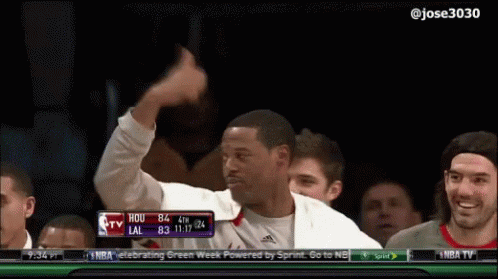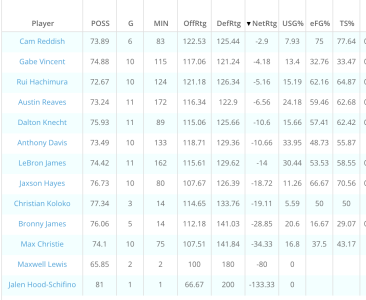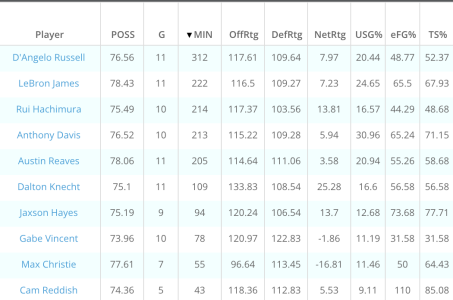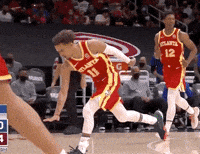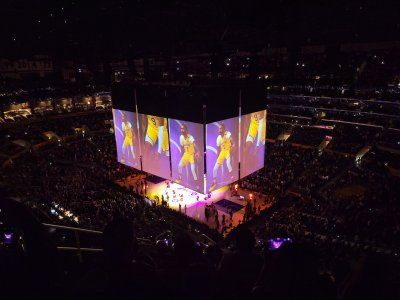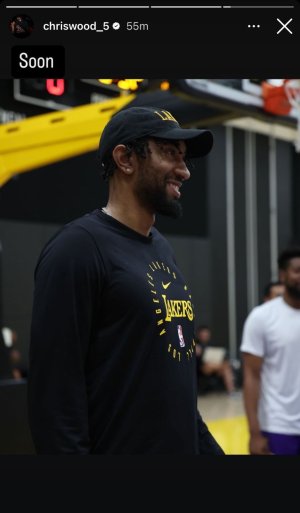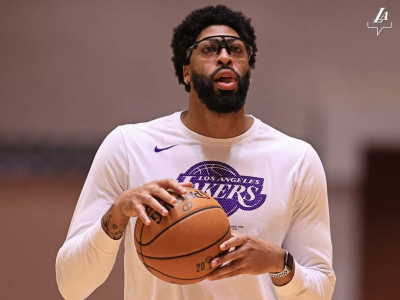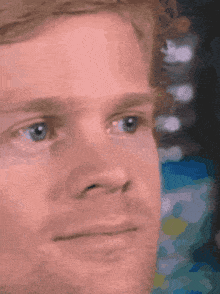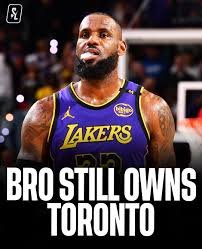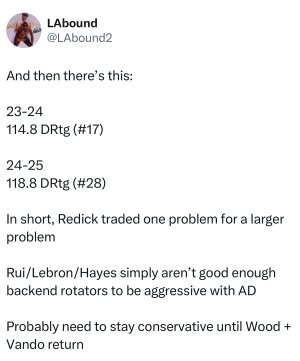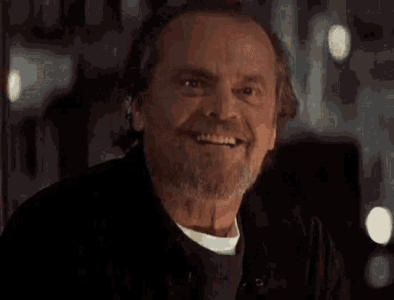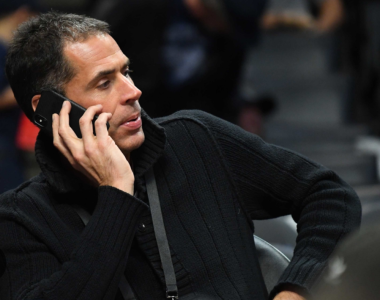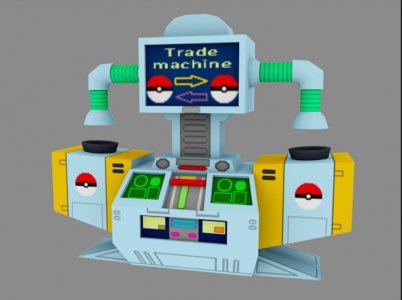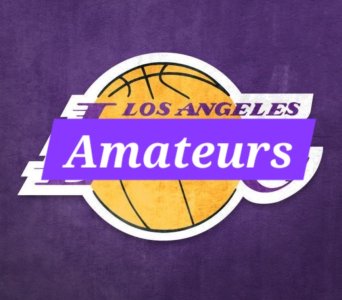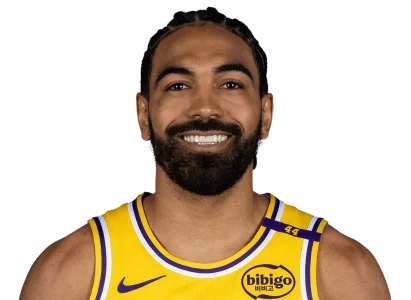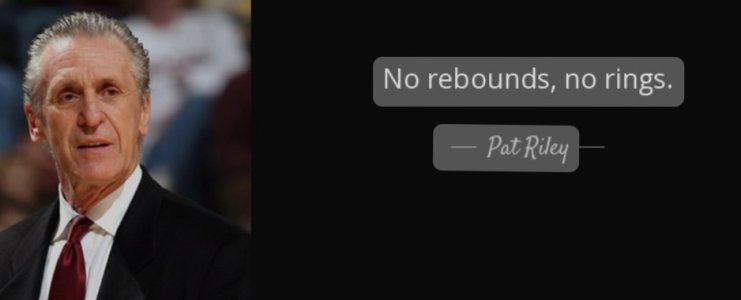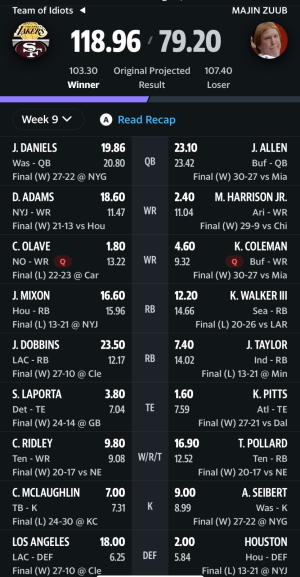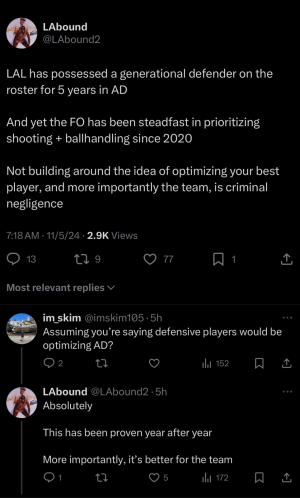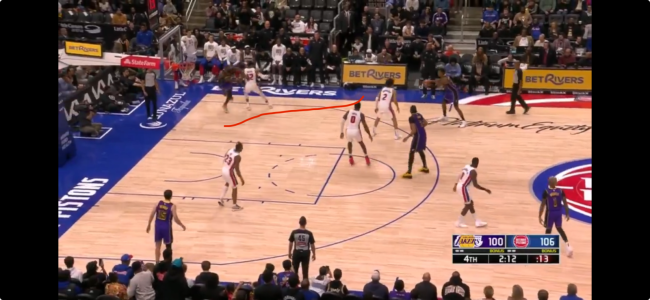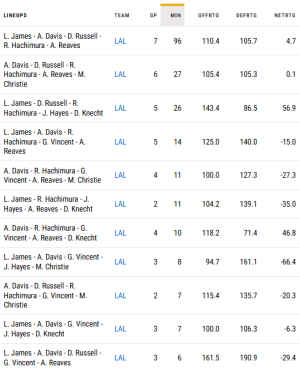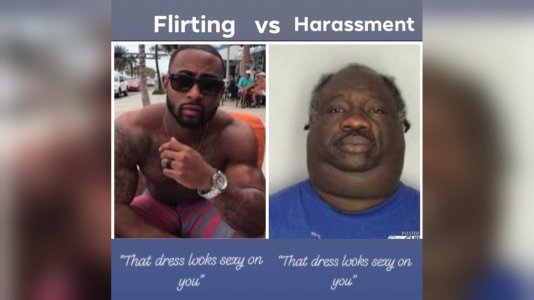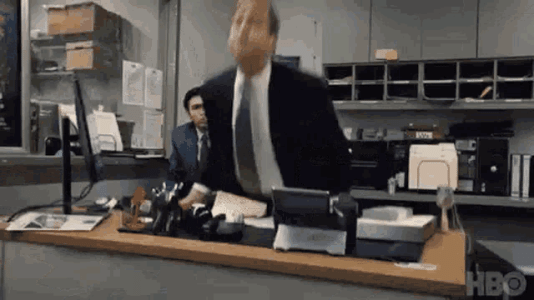- Sep 5, 2010
- 92,809
- 129,117
Can the Lakers improve their roster? Breaking down their options
The Lakers have enjoyed a bit of an uptick recently, finally gaining a small bit of momentum after a disturbingly mediocre start to their season. They have built a three-game winning streak against opponents who are either bad (Oklahoma City and Orlando) or injured (Dallas) — and six of their last eight — but major questions remain if they are going to establish themselves as contenders in the West.
While much of this month’s focus has been on coach Frank Vogel’s status, Wednesday marked the day most players in the league became eligible to be traded — although, importantly, not Lakers guard Talen Horton-Tucker, who isn’t eligible until Feb. 15 — making it a good time to consider what other avenues the Lakers could go to improve their team.
Rob Pelinka, the Lakers president of basketball operations, used up virtually all of the Lakers’ trade capital in July to trade for Russell Westbrook. As a result, the Lakers were pushed over the salary cap by their trio of All-Stars alone, forcing them to fill out a roster with veteran minimum contracts, not counting Horton-Tucker, whom they were able to re-sign using Bird rights, and Kendrick Nunn, whom they used their midlevel exception. More than 80 percent of the Lakers payroll is tied up in those five players.
In nearly five years at the controls, Pelinka has shown himself to be an ultra-aggressive executive, and it’s no surprise the Lakers would be linked to the glitziest stars potentially on the market, even if those might be pie-in-the-sky dreams.
What’s certain is the more the Lakers tread water, the more talks about roster upgrades will pick up. Entering Wednesday’s game in Dallas, Los Angeles ranked 11th in defensive rating but just 23rd in offense, and though the team hopes the eventual debuts of Trevor Ariza and Nunn will represent enough of a roster upgrade to erase some of the doubts that have been planted through the first third of the season, what happens if not?
Can the Lakers address their issues through the buyout market, which Pelinka has used in each of the past two seasons with, um, mixed results? Or, should they be thinking bigger?
To help sort out the Lakers’ options, I turned to The Athletic’s front office insider, John Hollinger.
Oram: OK, John, congratulations. You have just been hired as the new general manager of the Lakers. What is the first thing you are doing to get this team looking more like a contender?
Hollinger: Can I even do anything with this Oram guy from The Athletic blowing up my phone? Sheesh, man, it’s 3 a.m. Stop texting me about former Montana players for the G League.
So presuming I can’t go back in time and nuke previous trades, my first move is to bring together all of my performance people and trainers and figure out if there’s anything we can do to get LeBron James and Anthony Davis as close to their peak performances as possible, even if that means cutting their minutes, sitting them out games or whatever. The entire idea of this team is built on the idea of James and Davis being two of the best 10 players in the league, and if we’re being honest, they just haven’t been at that level this season. Davis sat out the two games over the weekend with knee pain after a stiff-looking performance against Memphis, and James’ numbers are also way down from his usual Everest heights.
After that, I have to canvas the league and figure out if there are any realistic trade possibilities. Sure, the Lakers will have “interest” in Ben Simmons, much as they will in virtually any good player, but the mechanics of acquiring such a talent without including James or Davis in the deal are almost nonexistent.
Oram: I would have to think the Lakers would open up a whole lot of new trade options if James or Davis were made available. But that’s not happening … right?
Hollinger: Snowball’s chance in Hades, my friend.
Oram: Fine, back to reality. What are the Lakers’ more likely options for improving this roster? Are we just talking buyout market again? Or do the Lakers have some under-the-radar tools for something bigger? If it’s buyout, that’s how the Lakers ended up in the Andre Drummond quagmire last year. As for trades, the guys with the two most tradeable contracts are Nunn, who has missed the entire season with a mysterious injury, and Horton-Tucker, who had a nice game against Orlando Sunday but has since landed in COVID-19 protocols. Horton-Tucker gets thrown around as the most-likely Laker to be traded for obvious reasons: He’s largely underperformed and doesn’t seem to be on the Lakers’ timeline but still has all the upside. L.A. needs him to be a consistent lockdown defender now, and that is likely still a ways away. If one or both of those guys is the centerpiece of a Lakers trade package, what is that getting them?
Hollinger: Here’s what Nunn and Horton-Tucker are getting them: the right to add draft picks to their salaries and get a player they actually want. Maybe that changes if Nunn ever plays in a game and performs like he did two years ago in Miami; on paper that is a value contract, but as you said, the longer Nunn is out, the more questions other teams are asking.
Teams like Horton-Tucker, but at $10 million a year and with an opt-out after 2023, his contract structure doesn’t make him as alluring a trade asset as you might think. There are only 18 months of team control before he’s an unrestricted free agent.
But realistically, virtually any player the Lakers will want makes at least $10 million a year, and as a luxury-tax team, the Lakers can only take back 125 percent of the money they send out. So any deal that brings in a salary in the teens has to include one or both of Horton-Tucker ($9,500,000 cap number) and Nunn ($5,000,000).
To get somebody who would actually help, the Lakers likely would have to include their 2027 first-round pick on top of that. The Lakers are restricted from trading any earlier first-round picks due to the Stepien Rule preventing trading first-round picks in consecutive years and the picks owed to New Orleans as a result of the Davis trade.
Oram: Nunn, Horton-Tucker and a first-round pick seems like a decent haul, albeit not for a superstar. The Lakers don’t need more of those, anyway. Who’s biting on that package, and who is worth it from the Lakers’ point of view? We know about the situations in Philadelphia and Portland, and John Wall wants out of Houston, but is there a logical trade partner for the Lakers? My mind immediately goes to Indiana, which The Athletic’s Bob Kravitz recently reported is looking to divest some of its top players.
Hollinger: OK, if we’re in dreamland but trying to temper it with at least a dose of reality, the one guy who stands out as a great fit is Indiana’s Malcolm Brogdon — who can’t be traded until after the season. Ugh.
Trading for Wall is only realistic if Westbrook is involved, and the Rockets already tried that. CJ McCollum makes too much for the salary match to work with Nunn and Horton-Tucker.
So the name I’m left with for the Lakers is Myles Turner. He makes $18 million, so his salary works if Nunn and Horton-Tucker are outbound. He’s already signed for next season at that number, so the Lakers’ salaries won’t get too out of hand in the final $47 million year on Westbrook’s deal. Turner plays center, which allows Davis to play his preferred power forward spot, but he’s a 3-point shooter who won’t get in the way like the current Laker centers do. His biggest weakness is rebounding, but Davis and LeBron are so good on that front, it probably won’t hurt L.A.
So what’s a fair price? Is an unprotected 2027 first-round pick enough for Indy? Would the Lakers need to pony up their two future seconds from Washington as sweeteners? Would $5 million cash do any talking? Do the Pacers even want to do this? Who knows, but this would be one of the first calls I’d make.
Oram: Let’s talk Westbrook. The Lakers went all in on him in July, and it’s not really Pelinka’s — or LeBron’s — style to concede defeat so early on, but Westbrook has been about what we expected: a clunky fit next to LeBron, but still capable of some seismic performances. The Simmons chatter stirred up some recent discussion about the Lakers’ willingness to trade Westbrook. Forget their willingness to trade him, but would there even be a market to take him on?
Hollinger: Doubtful. Setting aside the iffy basketball fit for most trade partners, the most difficult thing about trading Westbrook is just making a trade with Westbrook’s salary. He makes $44 million, which means the other team has to include at least $35 million in contracts just to make a legal deal.
For Philadelphia, for example, a theoretical deal of Simmons for Westbrook would require another $8 million in salary coming from the Sixers, who don’t have a lot of fungible contracts lying around. Yes, they could get there if they wanted to do it badly enough, but Simmons for Westbrook already seems like a reach; they have to throw in more players and still take on salary, too?
Even if the salary matches, the luxury tax is always a lurking problem for any team that would receive Westbrook, including Philly. Or, consider a Portland deal for McCollum and Robert Covington. That might be kind of interesting … except it puts the Blazers even further into the tax this year and likely complicates matters for them next year, as well.
Oram: Does that change in the summer, after Westbrook opts into the last year of his deal? Or next year, when his contract is expiring?
Hollinger: I think there are more Westbrook scenarios in the summer, yes, just because that is when teams have more flexibility in their books in general. But the $47 million problem doesn’t totally go away then. Most notably, remember the Lakers still can’t acquire a player in any realistic sign-and-trade scenario because of the hard cap, unless the inbound salary is significantly less than Westbrook’s outbound money. He’ll still be hard to trade — just slightly less hard.
Oram: Who are the likely buyout candidates when the time comes? Kevin Love, one of the obvious names coming into the season and someone who will always be tied to LeBron, seems content in Cleveland. Anybody you could see walking through that door in February or March?
Hollinger: I don’t see Love as a buyout guy, since he still has another year left on his deal. Besides, why would he go to a worse team? (Ducks.) Cleveland is 16-12 and looks awesome lately.
The thing with buyout guys in general is they only become buyout guys because nobody wanted to trade picks for them at the deadline. So you’re looking at a class of player that usually is only sort of useful, especially in a playoff environment. Goran Dragić, Terrence Ross, Covington, Thaddeus Young, Robin Lopez, Bryn Forbes … that’s your bailiwick here. If the Lakers are only playing like an average team in March, none of these guys are changing that.
The one potential exception I see is Wall, who isn’t a great fit in L.A. but might be so much more talented than the other available options that it doesn’t matter. More realistically, however, I’d see Wall wanting to go someplace he could start and re-establish his value, which isn’t the Lakers.
Oram: So to recap, you’d angle to get Myles Turner from Indiana. That’s the big swing. And if the Lakers are hoping for an impact player on the buyout market, then they’re already fundamentally doomed?
Hollinger: I mean, you still make the move to try to make your roster as good as possible … but pretty much. The biggest thing that moves the needle for this team, by far, is still LeBron James and Anthony Davis taking the court with a cape and giant “S” on their chests. There isn’t a trade out there that fixes that on its own.
The Lakers have enjoyed a bit of an uptick recently, finally gaining a small bit of momentum after a disturbingly mediocre start to their season. They have built a three-game winning streak against opponents who are either bad (Oklahoma City and Orlando) or injured (Dallas) — and six of their last eight — but major questions remain if they are going to establish themselves as contenders in the West.
While much of this month’s focus has been on coach Frank Vogel’s status, Wednesday marked the day most players in the league became eligible to be traded — although, importantly, not Lakers guard Talen Horton-Tucker, who isn’t eligible until Feb. 15 — making it a good time to consider what other avenues the Lakers could go to improve their team.
Rob Pelinka, the Lakers president of basketball operations, used up virtually all of the Lakers’ trade capital in July to trade for Russell Westbrook. As a result, the Lakers were pushed over the salary cap by their trio of All-Stars alone, forcing them to fill out a roster with veteran minimum contracts, not counting Horton-Tucker, whom they were able to re-sign using Bird rights, and Kendrick Nunn, whom they used their midlevel exception. More than 80 percent of the Lakers payroll is tied up in those five players.
In nearly five years at the controls, Pelinka has shown himself to be an ultra-aggressive executive, and it’s no surprise the Lakers would be linked to the glitziest stars potentially on the market, even if those might be pie-in-the-sky dreams.
What’s certain is the more the Lakers tread water, the more talks about roster upgrades will pick up. Entering Wednesday’s game in Dallas, Los Angeles ranked 11th in defensive rating but just 23rd in offense, and though the team hopes the eventual debuts of Trevor Ariza and Nunn will represent enough of a roster upgrade to erase some of the doubts that have been planted through the first third of the season, what happens if not?
Can the Lakers address their issues through the buyout market, which Pelinka has used in each of the past two seasons with, um, mixed results? Or, should they be thinking bigger?
To help sort out the Lakers’ options, I turned to The Athletic’s front office insider, John Hollinger.
Oram: OK, John, congratulations. You have just been hired as the new general manager of the Lakers. What is the first thing you are doing to get this team looking more like a contender?
Hollinger: Can I even do anything with this Oram guy from The Athletic blowing up my phone? Sheesh, man, it’s 3 a.m. Stop texting me about former Montana players for the G League.
So presuming I can’t go back in time and nuke previous trades, my first move is to bring together all of my performance people and trainers and figure out if there’s anything we can do to get LeBron James and Anthony Davis as close to their peak performances as possible, even if that means cutting their minutes, sitting them out games or whatever. The entire idea of this team is built on the idea of James and Davis being two of the best 10 players in the league, and if we’re being honest, they just haven’t been at that level this season. Davis sat out the two games over the weekend with knee pain after a stiff-looking performance against Memphis, and James’ numbers are also way down from his usual Everest heights.
After that, I have to canvas the league and figure out if there are any realistic trade possibilities. Sure, the Lakers will have “interest” in Ben Simmons, much as they will in virtually any good player, but the mechanics of acquiring such a talent without including James or Davis in the deal are almost nonexistent.
Oram: I would have to think the Lakers would open up a whole lot of new trade options if James or Davis were made available. But that’s not happening … right?
Hollinger: Snowball’s chance in Hades, my friend.
Oram: Fine, back to reality. What are the Lakers’ more likely options for improving this roster? Are we just talking buyout market again? Or do the Lakers have some under-the-radar tools for something bigger? If it’s buyout, that’s how the Lakers ended up in the Andre Drummond quagmire last year. As for trades, the guys with the two most tradeable contracts are Nunn, who has missed the entire season with a mysterious injury, and Horton-Tucker, who had a nice game against Orlando Sunday but has since landed in COVID-19 protocols. Horton-Tucker gets thrown around as the most-likely Laker to be traded for obvious reasons: He’s largely underperformed and doesn’t seem to be on the Lakers’ timeline but still has all the upside. L.A. needs him to be a consistent lockdown defender now, and that is likely still a ways away. If one or both of those guys is the centerpiece of a Lakers trade package, what is that getting them?
Hollinger: Here’s what Nunn and Horton-Tucker are getting them: the right to add draft picks to their salaries and get a player they actually want. Maybe that changes if Nunn ever plays in a game and performs like he did two years ago in Miami; on paper that is a value contract, but as you said, the longer Nunn is out, the more questions other teams are asking.
Teams like Horton-Tucker, but at $10 million a year and with an opt-out after 2023, his contract structure doesn’t make him as alluring a trade asset as you might think. There are only 18 months of team control before he’s an unrestricted free agent.
But realistically, virtually any player the Lakers will want makes at least $10 million a year, and as a luxury-tax team, the Lakers can only take back 125 percent of the money they send out. So any deal that brings in a salary in the teens has to include one or both of Horton-Tucker ($9,500,000 cap number) and Nunn ($5,000,000).
To get somebody who would actually help, the Lakers likely would have to include their 2027 first-round pick on top of that. The Lakers are restricted from trading any earlier first-round picks due to the Stepien Rule preventing trading first-round picks in consecutive years and the picks owed to New Orleans as a result of the Davis trade.
Oram: Nunn, Horton-Tucker and a first-round pick seems like a decent haul, albeit not for a superstar. The Lakers don’t need more of those, anyway. Who’s biting on that package, and who is worth it from the Lakers’ point of view? We know about the situations in Philadelphia and Portland, and John Wall wants out of Houston, but is there a logical trade partner for the Lakers? My mind immediately goes to Indiana, which The Athletic’s Bob Kravitz recently reported is looking to divest some of its top players.
Hollinger: OK, if we’re in dreamland but trying to temper it with at least a dose of reality, the one guy who stands out as a great fit is Indiana’s Malcolm Brogdon — who can’t be traded until after the season. Ugh.
Trading for Wall is only realistic if Westbrook is involved, and the Rockets already tried that. CJ McCollum makes too much for the salary match to work with Nunn and Horton-Tucker.
So the name I’m left with for the Lakers is Myles Turner. He makes $18 million, so his salary works if Nunn and Horton-Tucker are outbound. He’s already signed for next season at that number, so the Lakers’ salaries won’t get too out of hand in the final $47 million year on Westbrook’s deal. Turner plays center, which allows Davis to play his preferred power forward spot, but he’s a 3-point shooter who won’t get in the way like the current Laker centers do. His biggest weakness is rebounding, but Davis and LeBron are so good on that front, it probably won’t hurt L.A.
So what’s a fair price? Is an unprotected 2027 first-round pick enough for Indy? Would the Lakers need to pony up their two future seconds from Washington as sweeteners? Would $5 million cash do any talking? Do the Pacers even want to do this? Who knows, but this would be one of the first calls I’d make.
Oram: Let’s talk Westbrook. The Lakers went all in on him in July, and it’s not really Pelinka’s — or LeBron’s — style to concede defeat so early on, but Westbrook has been about what we expected: a clunky fit next to LeBron, but still capable of some seismic performances. The Simmons chatter stirred up some recent discussion about the Lakers’ willingness to trade Westbrook. Forget their willingness to trade him, but would there even be a market to take him on?
Hollinger: Doubtful. Setting aside the iffy basketball fit for most trade partners, the most difficult thing about trading Westbrook is just making a trade with Westbrook’s salary. He makes $44 million, which means the other team has to include at least $35 million in contracts just to make a legal deal.
For Philadelphia, for example, a theoretical deal of Simmons for Westbrook would require another $8 million in salary coming from the Sixers, who don’t have a lot of fungible contracts lying around. Yes, they could get there if they wanted to do it badly enough, but Simmons for Westbrook already seems like a reach; they have to throw in more players and still take on salary, too?
Even if the salary matches, the luxury tax is always a lurking problem for any team that would receive Westbrook, including Philly. Or, consider a Portland deal for McCollum and Robert Covington. That might be kind of interesting … except it puts the Blazers even further into the tax this year and likely complicates matters for them next year, as well.
Oram: Does that change in the summer, after Westbrook opts into the last year of his deal? Or next year, when his contract is expiring?
Hollinger: I think there are more Westbrook scenarios in the summer, yes, just because that is when teams have more flexibility in their books in general. But the $47 million problem doesn’t totally go away then. Most notably, remember the Lakers still can’t acquire a player in any realistic sign-and-trade scenario because of the hard cap, unless the inbound salary is significantly less than Westbrook’s outbound money. He’ll still be hard to trade — just slightly less hard.
Oram: Who are the likely buyout candidates when the time comes? Kevin Love, one of the obvious names coming into the season and someone who will always be tied to LeBron, seems content in Cleveland. Anybody you could see walking through that door in February or March?
Hollinger: I don’t see Love as a buyout guy, since he still has another year left on his deal. Besides, why would he go to a worse team? (Ducks.) Cleveland is 16-12 and looks awesome lately.
The thing with buyout guys in general is they only become buyout guys because nobody wanted to trade picks for them at the deadline. So you’re looking at a class of player that usually is only sort of useful, especially in a playoff environment. Goran Dragić, Terrence Ross, Covington, Thaddeus Young, Robin Lopez, Bryn Forbes … that’s your bailiwick here. If the Lakers are only playing like an average team in March, none of these guys are changing that.
The one potential exception I see is Wall, who isn’t a great fit in L.A. but might be so much more talented than the other available options that it doesn’t matter. More realistically, however, I’d see Wall wanting to go someplace he could start and re-establish his value, which isn’t the Lakers.
Oram: So to recap, you’d angle to get Myles Turner from Indiana. That’s the big swing. And if the Lakers are hoping for an impact player on the buyout market, then they’re already fundamentally doomed?
Hollinger: I mean, you still make the move to try to make your roster as good as possible … but pretty much. The biggest thing that moves the needle for this team, by far, is still LeBron James and Anthony Davis taking the court with a cape and giant “S” on their chests. There isn’t a trade out there that fixes that on its own.
 at Kevin Love deciding between CLE and LAL IF he could get a decent buyout. He'd be on the first thing smokin. Be ******* real.
at Kevin Love deciding between CLE and LAL IF he could get a decent buyout. He'd be on the first thing smokin. Be ******* real.









